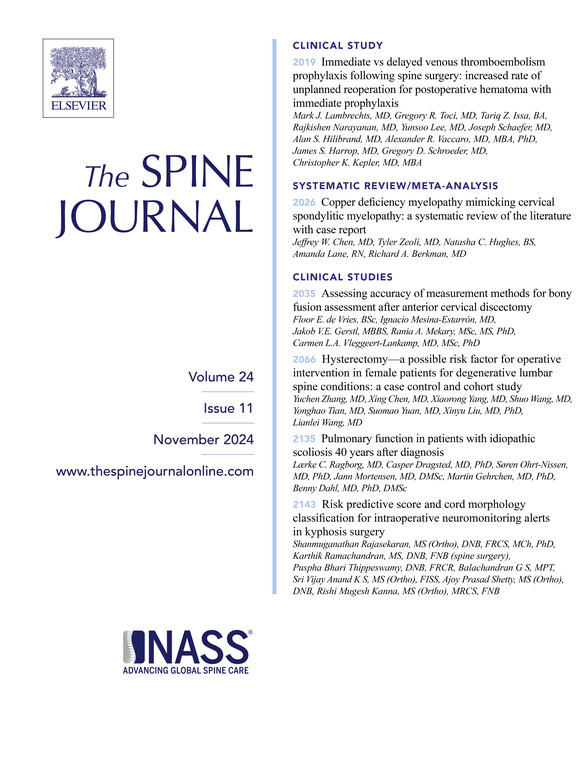Is orthotic treatment beneficial for fresh osteoporotic vertebral fractures? A propensity score matching study
IF 4.9
1区 医学
Q1 CLINICAL NEUROLOGY
引用次数: 0
Abstract
BACKGROUND CONTEXT
Orthotic treatment is a common option for the conservative treatment of osteoporotic vertebral fractures (OVF). However, there is insufficient evidence of its clinical benefit.
PURPOSE
To investigate the effectiveness of orthotic treatment for OVF.
STUDY DESIGN/SETTING
Retrospective cohort study with data from two prospective studies.
PATIENT SAMPLE
This study included 160 patients with fresh OVF enrolled in 2012 and 2020 prospective cohort studies.
OUTCOME MEASURES
The visual analog scale (VAS) score for low back pain was used for clinical outcomes, and radiographic parameters included the percent height of the vertebra and angular change of the vertebral body. Moreover, the occurrence of secondary vertebral fractures was followed-up over time.
METHODS
The patients were divided into brace and no-brace groups and were matched according to propensity score for age, sex, anterior percent height at the initial examination, and presence of old OVFs. Hazard ratio for the cumulative incidence of secondary vertebral fractures with and without bracing were calculated and analyzed using the generalized Wilcoxon test. In addition, the brace group was divided into soft and rigid brace groups and compared with the no-brace group.
RESULTS
Each group had 61 cases after propensity score matching. There were no significant differences in the VAS improvement for low back pain and the change in percent height of the anterior and posterior walls from initial examination to 6 months after injury (p=.87, p=.39 and p=.14, respectively, mixed-effect models). Meanwhile, the mean angular change of fractured vertebrae was 4.3° / 3.2° initially and 1.2° / 2.5° at 6 months (the brace group / no-brace group, respectively; p=.007, mixed-effect models). A significant difference was also observed between the rigid brace group and the no-brace group (p=.008, mixed effect models). The incidence of secondary vertebral fractures was 1.6% / 11.4% at 1 month, indicating a significant difference (the brace group / no-brace group, respectively; p=.028). The hazard ratio for the cumulative incidence of secondary fractures due to orthotic treatment was 0.47 (95% confidence interval 0.20–1.09, p=.054).
CONCLUSIONS
Although orthotic treatment for fresh OVF did not relieve pain, it might contribute to the stabilization of the fractured vertebra, especially using a rigid brace. Moreover, it might influence a reduction of the imminent vertebral fracture risk immediately after the onset of OVF.
Classifications
Clinical study
矫形治疗是否有益于新发骨质疏松性椎体骨折?倾向得分匹配研究》。
背景情况:矫形治疗是保守治疗骨质疏松性脊椎骨折(OVF)的常见选择。目的:研究矫形治疗对骨质疏松性脊椎骨折的有效性:患者样本:本研究纳入了2012年和2020年前瞻性队列研究中入选的160名新鲜OVF患者:临床结果采用腰背痛视觉模拟量表(VAS)评分,放射学参数包括椎体高度百分比和椎体角度变化。此外,还对继发性椎体骨折的发生情况进行了长期随访:将患者分为有支架组和无支架组,并根据倾向得分对年龄、性别、初次检查时的前方高度百分比和是否存在陈旧性椎体后凸骨折进行配对。使用广义 Wilcoxon 检验计算并分析了有支具组和无支具组继发性椎体骨折累积发生率的危险比。此外,还将支架组分为软支架组和硬支架组,并与无支架组进行比较:结果:经过倾向得分匹配后,每组均有 61 个病例。从初次检查到受伤后 6 个月,腰痛 VAS 改善程度和前后壁高度百分比的变化无明显差异(混合效应模型,分别为 p = 0.87、p = 0.39 和 p = 0.14)。同时,骨折椎体的平均角度变化最初为 4.3°/3.2°,6 个月时为 1.2°/2.5°(支撑组/无支撑组,分别为 p = 0.007,混合效应模型)。硬质支撑组与无支撑组之间也存在明显差异(p = 0.008,混合效应模型)。1 个月时继发性椎体骨折的发生率为 1.6% / 11.4%,显示出显著差异(支架组/无支架组分别为 1.6% / 11.4%;p = 0.028)。矫形治疗导致的继发性骨折累积发生率的危险比为0.47(95%置信区间为0.20-1.09,P = 0.054):结论:尽管对新鲜室间隔缺损进行矫形治疗并不能缓解疼痛,但它可能有助于稳定骨折的椎体,尤其是使用硬质支具。此外,矫形治疗可能会降低OVF发病后立即发生椎体骨折的风险:临床研究。
本文章由计算机程序翻译,如有差异,请以英文原文为准。
求助全文
约1分钟内获得全文
求助全文
来源期刊

Spine Journal
医学-临床神经学
CiteScore
8.20
自引率
6.70%
发文量
680
审稿时长
13.1 weeks
期刊介绍:
The Spine Journal, the official journal of the North American Spine Society, is an international and multidisciplinary journal that publishes original, peer-reviewed articles on research and treatment related to the spine and spine care, including basic science and clinical investigations. It is a condition of publication that manuscripts submitted to The Spine Journal have not been published, and will not be simultaneously submitted or published elsewhere. The Spine Journal also publishes major reviews of specific topics by acknowledged authorities, technical notes, teaching editorials, and other special features, Letters to the Editor-in-Chief are encouraged.
 求助内容:
求助内容: 应助结果提醒方式:
应助结果提醒方式:


